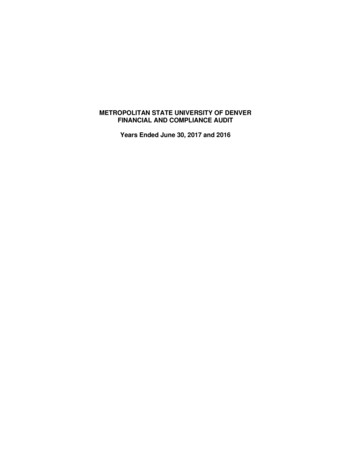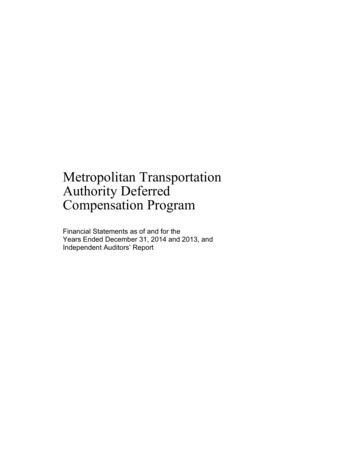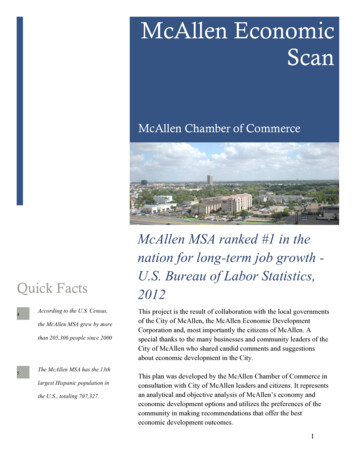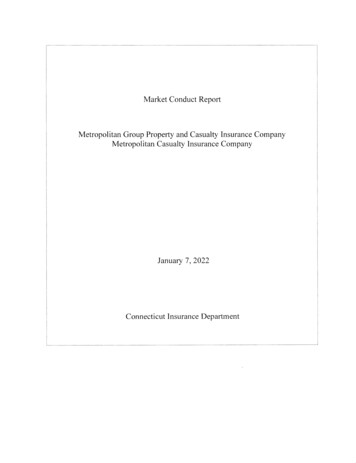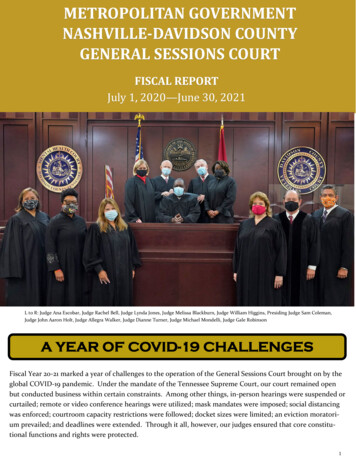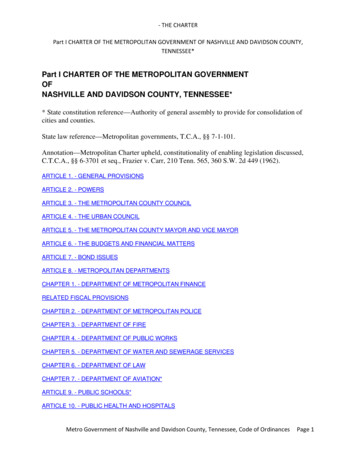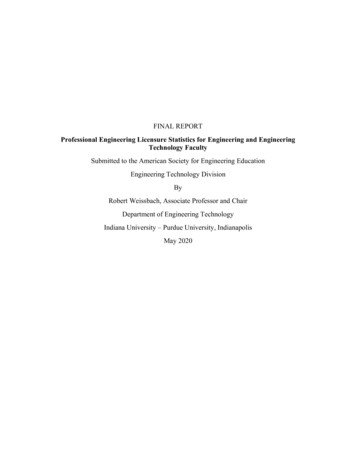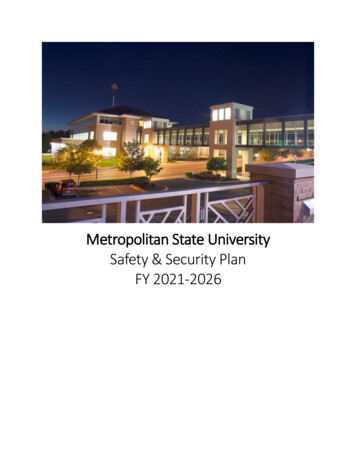
Transcription
Metropolitan State UniversitySafety & Security PlanFY 2021-2026
Safety & Security Plan, 2021 - 2026Table of ContentsAbout Metropolitan State University . 4Our Mission . 4Our Vision . 4Our 2020-2024 Strategic Plan: Building A Resilient, Student Ready University . 4The Current Safety, Security, and Emergency Management Program . 5Staffing. 5Other Recent Security Improvements (Calendar Years 2018 – 2019) . 5Security Department Oversight . 72020 Planned Security Enhancements . 8COVID-19 (SARS-CoV-2) . 9Security Connections within the University . 9Safety Committee . 9Care Team .10Behavioral Intervention Team .11Counseling Services Office .12Clery Compliance Workgroup .12Safety & Security Communications .13Star Alert System.13Emergency Security Notifications.14Clery Timely Warning Notice or Security Alerts.14Security Warning Notices on Doors.14Preventative Security/Safety Alerts .14Metropolitan State University Security Directory .15Campus Feedback .15Security Assessment/Risk Mitigation .16Recommendation 1: Electronically Locked Access Control System/Shrouded Locks .16Recommendation 2: Exterior Door Markings .17Recommendation 3: Closed-Circuit Television System (CCTV/Video Surveillance) .17Recommendation 4: Intrusion Detection System (IDS) Upgrade .17Recommendation 5: Security Operations Center .18Recommendation 6: Campus Lighting .18Recommendation 7: Training on Emergency Response Plans .19April 27, 2020Page 2
Safety & Security Plan, 2021 - 2026Recommendation 8: SafeTea Talks .19Items for Further Evaluation and Consideration .20Consideration 1: Proprietary Security (In-house Security) .20Consideration 2: Reposition of Security Desk in Library .20Consideration 3: Creation of Security Office in Library.21Consideration 4: Act of Violence Platform .22Consideration 5: Door Barricades .22Environmental Assessment .24Conclusion.33April 27, 2020Page 3
Safety & Security Plan, 2021 - 2026About Metropolitan State UniversityOur MissionMetropolitan State University is a comprehensive urban university committed to meeting thehigher education needs of the Twin Cities and greater metropolitan population.The university will provide accessible, high-quality liberal arts, professional, and graduateeducation to the citizens and communities of the metropolitan area, with continued emphasison underserved groups, including adults and communities of color.Within the context of lifelong learning, the university will build on its national reputation forinnovative student-centered programs that enable students from diverse backgrounds toachieve their educational goals.The university is committed to academic excellence and community partnerships throughcurriculum, teaching, scholarship, and services designed to support an urban mission.Our VisionMetropolitan State University, a member of the Minnesota State College and University System,will be the premier urban, public, comprehensive system university in the Twin Citiesmetropolitan area and will provide high-quality, affordable educational programs and servicesin a student-centered environment.The faculty, staff, and students of Metropolitan State will reflect the area’s rich diversity, build aculturally competent and anti-racist learning community, and demonstrate an unwaveringcommitment to civic engagement.Our 2020-2024 Strategic Plan: Building A Resilient, Student Ready UniversityStrategic Commitment #1: Set standards for student-centered support that meets theparticular needs of subgroups of students based on identified demographic student profiles as ameans to increase degree completion for all students.Strategic Commitment #2: Provide distinctive, high quality, accessible, and affordableeducational opportunities for post-traditional learners.Strategic Commitment #3: Create a culture that supports and celebrates dynamic, innovativeteaching that results in learning environments that effectively engage post-traditional learnersin transformative and relevant learning and distinguishes Metropolitan State Universitygraduates.Strategic Commitment #4: Strategically develop and maintain relationships and partnershipswith urban and metropolitan area communities, businesses, non-profits, donors and alumniApril 27, 2020Page 4
Safety & Security Plan, 2021 - 2026based on mutual benefit that clearly enriches the student learning experience, provideenhanced opportunities for students to meet their employment goals, influencethe understanding of and value that local employers and the community afford to abaccalaureate level education, and/or advance the financial interests of the University.Strategic Commitment #5: Model a culture of respect, equity, and inclusion for students,faculty, staff, and partners.Strategic Commitment #6: Build structural and foundational systems and processes that alignphysical, financial, and human resources to increase institutional efficiency, effectiveness, andsustainability.The Current Safety, Security, and Emergency Management ProgramThe Safety and Security Office is a part of the Campus Operations Department in the Financeand Operations Division of the university.StaffingFor at least the past 10-years, the program consisted of less than one full FTE employee. Theposition was just one of the duties of the then-director of security and auxiliary servicesposition. This position was also responsible for oversight of several other operational areaswithin the university, such as parking, ergonomics, and the university bookstore. Thisarrangement resulted in too many competing demands for the director’s time and focus.Therefore, during the summer of 2019, the Campus Operations Department was reorganized tocreate a full-time FTE security director position, which now focuses exclusively on security andemergency management tasks.Other Recent Security Improvements (Calendar Years 2018 – 2019)Metropolitan State University is dedicated to the safety and security of everyone on ourcampus – students, employees, and visitors – and recognizes the importance of continuousevaluation and improvements to the safety, security and emergency management program.Listed below are some of the changes/improvements made since January of 2018:Account Manager - In the fall of 2018, Metropolitan State University added the accountmanager position as a new layer of supervision to our contracted security. The accountmanager oversees the contractor’s day-to-day operations and staffing. Some of theenhancements were made immediately: increased patrolling, cross training among the variousposts at the university, and additional training regarding customer service, incident response,and a new concierge-type focus.April 27, 2020Page 5
Safety & Security Plan, 2021 - 2026Incident Reporting – Security implemented a new online incident reporting system calledReport Exec on November 1, 2019. This system allows security to report incidents withinminutes and distribute reports and information to those who need to know or act. Along with amore robust program of documenting incidents, it will create real-time metrics that can beprovided to stakeholders regarding the security of our university. The system also integrateswith Maxient. This will also allow a reduction in paper waste along with improved responsetimes for our security teams. The system has been fine-tuned to fit our mission, policies, andpractices to ensure a safer tomorrow.Code Blue Phones – In the past, these phones were answered and operable only duringuniversity open hours and were only connected to security officer cell phones. We haveimproved the system so that these calls are answered 24/7 by our alarm monitoring servicewhich can contact the appropriate law enforcement agency, university security, or facilitiesstaff.Security Assessment – The university contracted with a third-party vendor to complete a fullsecurity assessment of our physical and electronic security measures and key aspects of thefindings are included in this plan. Recommendations from the assessment address our securityforce, CCTV system, and physical accessibility vulnerabilities.Radio Communications – The security department collaborated with the facilities and ITdepartments to order an integrated system of radios. These radios will facilitate fastercommunication and response times among and between these departments at the universityand allow more seamless communications during incidents on campus.Campus Security Authority (CSA) Training – The university has defined its designated CampusSecurity Authorities (CSAs), in accordance with the Federal Jeanne Clery Disclosure of CampusSecurity Policy and Campus Crime Statistics Act. The university hired D. Stafford and Associatesto come on campus in September to conduct training for CSAs.Clery Compliance Workgroup – In 2019, the university convened a Clery ComplianceWorkgroup. Establishment of such a workgroup is considered a best practice for ensuringcompliance with and adequate review of the university’s compliance with the Federal JeanneClery Disclosure of Campus Security Policy and Campus Crime Statistics Act.Clery Act Training – The university hired D. Stafford and Associates to train members of theClery Compliance Workgroup and several other key stakeholders in September 2019.Connections to Saint Paul Police Department – The university has developed a closerelationship with the local SPPD commanders and several patrol officers. The SPPD now alsohas copies of the floor plans for the university and the plans are loaded into the SPPD system soin the event of an on-campus emergency, SPPD officers will be directed to the correct location.The university also held two open forums with our local SPPD district Senior Commanders, oneforum at the Saint Paul location and one at the Midway location.April 27, 2020Page 6
Safety & Security Plan, 2021 - 2026Connections with Community – The Security Director has made connections with securitypersonnel for the First Lutheran Church and local shelter. The Director plans to developadditional connections with other community groups.Phone system upgrade – Project includes updating all campus desk/room phones with Ciscophones. These phones also are connected to the 911 location service among other capabilitiesyet to be implemented regarding safety. Current status is on hold due to the migration to O365and multiple other projects. Will resume shortly.Cellular Enhancement for Midway – This project was to increase the cell reception in the lowerportions of the Midway Campus as the coverage was weak. Metropolitan State Universitypartnered with Wellington Management to complete the project. Reception has improveddrastically at the campus. The biggest hurdle was getting 4 major carriers (AT&T, T-Mobile,Sprint and Verizon) to buy into the projectFine Arts Studio – A security assessment was completed on the Fine Arts Building. Additionalinfrastructure was installed, including panic alarms and phone system. Operational protocolshave been implemented, including frequent patrols. Card readers have been ordered and willbe installed as well as additional security sensors, a push bar for egress, and a peephole in theaccessibility access door in 2020.Security Department OversightContracted Security – The largest aspect of the security department is the oversight of the dayto-day operations of the contracted security vendor and their security officers deployed at theuniversity. This includes the day-to-day operations of the team, ensuring compliance withcontractual obligations, reviewing and management of key performance indicators, such asstaffing hours, invoice accuracy, training records, and compliance with university policies.Coordination with contractor’s leadership is also necessary for special coverage, additionalresources, and training.Clery Compliance – The security department is the central coordination point to ensurecompliance with the Clery Act. The university security director is the designated CleryCompliance Officer and is tasked with convening the Clery Compliance Workgroup, training theCampus Security Authorities (CSAs), maintaining an accurate Daily Crime Log, statisticalrecordkeeping and report for any Clery reportable security incident, and publishing the AnnualSecurity Report, among other tasks.Emergency Management Coordination – The department is tasked with developing andmaintaining the disaster and evacuation planning, continuity of operations plan (COOP) andtraining for staff regarding the plans, and building and maintaining the communication andplanning with local law enforcement, emergency managers, and first responders.April 27, 2020Page 7
Safety & Security Plan, 2021 - 2026Surveillance and Life Safety Equipment – Along with monitoring the CCTV, the securitydepartment works closely with campus operations, facilities, IT, and maintenance staff toensure the life safety systems, such as CCTV, building alarms, AED and Narcan deployment, arefully operational.Student Safety – Metropolitan State University security officers are present at two locations,Dayton’s Bluff and Midway. We also have students attending classes at over 20 differentlocations with their own security practices. Security must ensure the safety of students andstaff at all of these locations. Security also monitors all overnight sponsored travel throughoutthe world.2020 Planned Security EnhancementsTraining – We are currently working to create and deploy specific training programs tailored toour needs at Metropolitan State University. The training will focus on trauma informed care,de-escalation techniques, crisis intervention, and community outreach.Radio Communications – The radios ordered in 2019 have arrived and will be deployed in earlycalendar year 2020.Policies & Procedures – We are planning a comprehensive review and update of all safety,security, or emergency-management policies.University Travel – Protocol and forms have been updated to include the addition of CSAinformation on student travel approval forms and the requirement to notify the securitydirector of all student travel and employee international travel.Clery Compliance – We have created the Clery Compliance Workgroup to address the broadgovernance needs associated with Clery Act compliance. This group assists with training,improving the Annual Security Report, policy review and updating, data collection processimprovements, and increasing awareness across divisions regarding the Clery Act.Optimizing Report Exec – The security department is responsible for implementation andoperational oversight of the Report Exec incident and records management system. This webbased software allows for more accurate incident reports, analytics associated with eachlocation, and improved responses from security officers.Overnight Security Presence – With the transition to the new security vendor, Allied Security,the university finally achieved a comprehensive security presence, spanning 24 hours per day,seven days per week. Campuses having a continuous security presence is a post 9/11 securitybest practice. Overnight coverage allows us to more quickly thwart illegal activity on campus,identify suspects, monitor intrusions, or alert the Saint Paul Police Department of activecriminal activity on campus.April 27, 2020Page 8
Safety & Security Plan, 2021 - 2026COVID-19 (SARS-CoV-2)COVID-19 is a severe acute respiratory syndrome, also known as the Coronavirus. In 2020, theWorld Health Organization declared COVID-19 a pandemic. In response to guidance from theU.S. Centers for Disease Control and the Minnesota Department of Health, and in response thedirectives of Governor Walz, the university temporarily suspended in-person classes and eventson campus. Classes were temporarily move to alternate instruction methods beginning afterSpring Break 2020.For the duration of the COVID-19 outbreak, the Security Director and the Safety Committee willwork to optimize safety for students, faculty, staff, visitors, and community members at everyUniversity site. The Security Director will serve, as needed, on and with the University’s COVID19 Response Team to align security directives and this Safety & Security Plan with best practicesas guided by the University President, the System Chancellor, the Governor of the State ofMinnesota, the federal Centers for Disease Control, and other relevant governmental andmedical leaders and decision-makers. Substantial changes to this plan necessitated during theCOVID-19 pandemic will be promptly disseminated to all University stakeholders. The result ofthis pandemic will be improved response, a revised Pandemic Plan, action items to ensure theuniversity is better positioned for a future pandemic, and understanding of how we can bemore flexible in nearly every aspect of delivering upon higher learning outcomes.Security Connections within the UniversityThis section identifies the key groups on campus which play an integral role in the overallCampus Safety, Security, and Emergency Management program.Safety CommitteePurposeMetropolitan State University is required to have a committee per Minnesota AdministrativeRule 5208 and Minnesota Statutes section 182.676. The Committee provides labor and theuniversity provides a cooperative opportunity to promote a safe and secure workplace to whichboth are committed. This committee reports up to the Resource Planning and AlignmentCouncil in the university’s governance structure.Membership Director of Operations, Chair Director of Safety and Security Human Resources IFO Representative Student Senate Representative MSUAASF Representative MMA RepresentativeApril 27, 2020Page 9
Safety & Security Plan, 2021 - 2026 MAPE RepresentativeAFSCME RepresentativeVice President for Finance and Operations (Executive Sponsor)Role and EngagementDecision-making will follow the University’s Council framework: Provide ideas for improving the public safety or security of the University.Assist in the creation and/or review of University public safety or security programs,processes, policies, and/or procedures and provide advice on the same.Assist in modifying and updating the Emergency Management Plan.Review and recommend actions on all public safety or security appeals to the VP/CFOfor final decision.Provide advice and counsel to the President and the President’s Executive Councilthrough the Resource Planning and Alignment Council via the VP/CFO on theUniversity’s current and proposed public safety and security objectives.Care TeamPurposeThe team is to respond to student referrals, act as a network to assist the student of concern,work to provide advocacy, work with the Behavioral Intervention Team, and continue toprovide referrals as appropriate.Membership Dean of Students, Chair Center for Accessibility Resources designee Financial Aid office designee Gateway Director and Ombudsperson Registrar’s office designee Counseling Services Staff Counselor/Case Manager (Staff Psychologist alternate) Student Parent and Resource Coordinator Student Live and Leadership Development designee TRIO designee Academic advisor (plus one alternate) T3 IFO FA members (plus one alternate)The Dean of Students and Counseling Services’ Counselor/Case Manager belong to both theCARE and BIT. This allows for transparency and communication between CARE and BIT.Role and EngagementApril 27, 2020P a g e 10
Safety & Security Plan, 2021 - 2026The CARE team works collaboratively with students of concern and the staff and facultysupporting them to help address barriers to retention and holistic wellbeing. This might includeteam members providing their knowledge, expertise, and resources to engage in traumainformed and culturally responsive CARE plans that will empower the student to self-determinethe best pathways to success. Larger procedural and policy recommendations will be made tothe Team members for consideration or recommendation/review to PEC and President.Operational considerations: Attendance is important to maintain caseloads and to develop as a team. If a teammember is not able to attend regularly, the chair will reach out to them to determinetheir continued availability.If a team member is to be absent, they should report their absence as soon as possiblein advance to the Dean of Students.A minimum of three (3) team members must be present to conduct business.Counseling Center staff will be present for consultations but cannot share specificinformation about any individual student without an appropriate release of informationon file from that student, unless there is indication of imminent danger.The Associate Provost will provide a yearly operating budget for needed resources.The CARE Team will create additional policies, procedures, and protocols that define theremainder of pertinent team operations, which will be available on the shared drive andencompass best practices.Behavioral Intervention TeamPurposeThis group serves to gather information, assess, use reasoned analysis, and provide supportiveintervention services to our students, especially during an emerging or perceived threat ofharm to self or others.Membership Dean of Students (Chair) Security Director Director of Counseling services Mental Health Counselor Associate Provost (alternate to Dean of Students) Vice President for Finance and Operations (alternative to Security Director) Staff Psychologist (alternate to Director of Counseling or Mental Health Counselor) Other Subject matter experts as neededApril 27, 2020P a g e 11
Safety & Security Plan, 2021 - 2026Role and Engagement Provide early support for and intervention to students exhibiting behaviors of concern inorder to best serve them and enhance their opportunities for success as well as toprotect the university community, including but not limited to referral to CARE team forongoing support resources; Receive reports from members of the campus community about concerning ordisruptive student behaviors; Address these reports through an established threat assessment and managementprocess; Develop and select potential interventions and responses that are informed by theassessment process; Assign and communicate roles and responsibilities for implementation of interventionsand responses to appropriate individuals, including the student of concern, BITmembers, faculty, staff, and community resources; Follow up on interventions to address their effectiveness, and adjust as needed; Inform the university community of the BIT, and educate and empower universitycommunity members regarding the need, purpose, and mechanisms for reporting andintervention; and Provide education and consultation to the University community regarding respondingto students of concern.Counseling Services OfficeThe Counseling Services Office seeks to help students live their best lives by providing personalcounseling, case management, and prevention-focused outreach services. Counseling Servicesoffers both personal counseling and academic skills coaching to assist students with concernsthat might interfere with their educational success.Personal counseling includes interpersonal relationships, emotional issues, grief and loss,trauma, stress, and more.Individual consultation in study skills, time management, concentration, and test taking is alsoavailable.Student Counseling Services staff are also available to provide case managementappointments, which seeks to connect students to resources that can help with basic needsconcerns, such as food insecurity, housing, financial difficulty, health issues, and more.Clery Compliance WorkgroupPurposeApril 27, 2020P a g e 12
Safety & Security Plan, 2021 - 2026This group’s main goal is to ensure the university’s compliance with Clery Act requirements,including oversight of the Annual Security Report, Campus Security Authority training program,policy development, and reviewing Clery reportable crimes.Membership Security Director, Clery Compliance Officer Dean of Students Security Captain (contractor) Environmental Health and Safety Officer Director of Operations Chief Human Resources Officer Women’s and LGBTQ Student Service Coordinator Campus Diversity Officer Associate Provost (alternate to Dean of Students) Vice President for Finance and Operations Assistant Human Resources Director for Talent Management (alternate to Chief HumanResource Officer, and resource to the workgroup)Role and Engagement Charged with the primary function of identifying and evaluating processes, proceduresand practices to manage compliance with the Clery Act. Responsibility to develop, or assign, each Clery Act policy statement requirement to theappropriate person/area to review for accuracy prior to publication of the AnnualSecurity Report. Reviews all Timely Warning Notices, the Daily Crime Log, and Emergency NotificationRequirements. Reviews handling of major incidents to determine Clery reportability Reviewing all Clery Act Updates Reviews other institutions’ Annual Security Reports.Safety & Security CommunicationsStar Alert SystemThe Star Alert System will be used to provide university-wide notifications to all MetropolitanState University email addresses. Star Alerts will also be sent via voice, text, or additional emailaddresses for those who have opted in to the system. Star Alerts will be issued for the followingtypes of notices: Emergency Security NotificationsApril 27, 2020P a g e 13
Safety & Security Plan, 2021 - 2026 Timely Warning Security NotificationsInitiation of lockdown proceduresUnexpected closure of a facility due to a mechanical or environment incident (e.g. gasleak, chemical spill, impeding weather)Emergency Security NotificationsEmergency Security Notifications are required by the Clery Act when an institution determinesthat a crime for which it must report statistics — such as a homicide, sex offense or robbery —presents a serious or continuing threat to students and employees. A Star Alert will
staffing hours, invoice accuracy, training records, and compliance with university policies. Coordination with contractor's leadership is also necessary for special coverage, additional resources, and training. Clery Compliance - The security department is the central coordination point to ensure compliance with the Clery Act.
